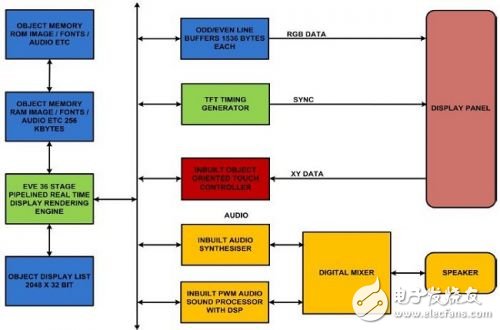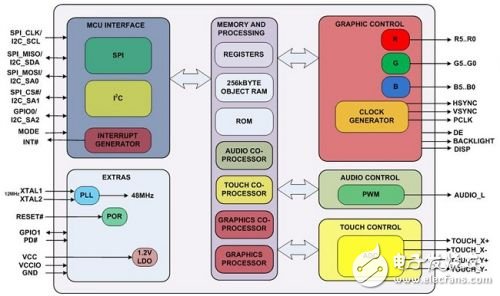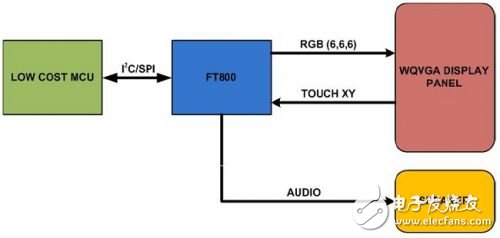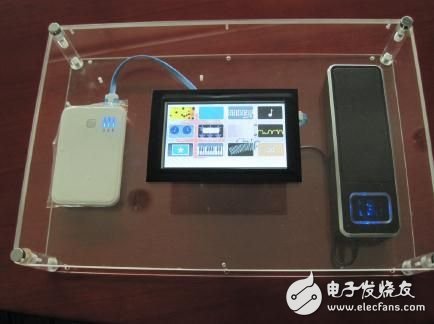Today's smart display designs are complex, often requiring the use of 32-bit high-end processors (with a large number of I/O interfaces and external memory), high cost and board space, graphics libraries (and sometimes embedded operating systems), Expensive frame buffer chip (as display memory), as well as touch and audio to achieve (Figure 1).
To meet the needs of more advanced human-computer interaction and to deal with cost, power consumption and design difficulty, FTDI has launched the FT800 (Figure 2, Figure 3), the first chip in the Embedded Video Engine (EVE) series. The graphics display controller chip uses an object-oriented (line buffer) method instead of the traditional frame buffer. At the same time, the FT800 integrates display, touch and audio controls to make the design of the HMI easier.

Figure 1: The current smart display structure.

Figure 2: EVE's object-oriented intelligent display structure.

Figure 3: FT800 frame diagram.
Huang Yilong, Asia-Pacific technical marketing manager of FTDI, said that the traditional screen design is more difficult, and the system and resources are relatively expensive. FTDI's innovative EVE technology solves the design challenges of electronics engineers. This innovative product is different from all screen controllers on the market, and is superior in cost, function and quality.
With the FT800, the system can be designed using low-cost MCUs (ATmega328, PIC or 8051, etc.) (Figure 4). The 48-pin QFN package reduces PCB size. The SPI/I2C optional interface communicates with the MCU to reduce pin count and simplify the interface. With 18 data bits, WQVGA graphics of 262k colors (RGB–6, 6, 6) can be achieved. In addition, the chip also provides a touch controller and audio output.

Figure 4: System structure diagram using FT800.
Typically, each pixel on the display requires 3 bytes (one byte each of red, green, and blue) to control the display. The traditional frame buffering method requires 760 KB of RAM for support. At the same time, in order to reduce the influence of time difference and interference, it is necessary to use a high-end MCU to quickly refresh the screen in order to obtain high-quality display effects. To reduce pin count, the FT800 uses the I2C/SPI interface for communication. The object-oriented approach solves the problem of swiping caused by slow I2C/SPI interface speed by pre-storing up to 2000 objects (sounds, photos, etc.) into an 8KB display list. At the same time, the method also eliminates the need for graphics libraries and embedded operating systems such as Android.
In addition, EVE's object-oriented approach allows images to be rendered with 1/16 pixel precision on a line-by-line basis. This makes it smoother when calculating dynamic displays. The built-in anti-aliasing function of the FT800 can solve the problem of interference on the resistance screen and display. The chip implements 24-bit full color support using an 18-bit interface (6 bits each in RGB). The FT800 uses color dithering technology to change the refresh rate of each point, which can compensate for the 2-bit color difference and achieve the color matching effect. The Alpha blending algorithm creates shadow, 3D, and fade effects.
The FT800 supports WQVGA (480x272) and QVGA (320 & TImes; 240) image display, with a maximum support of 512 pixels & TImes; 512 pixels (Figure 5). Built-in gadgets make it easy to draw simple graphics such as clocks, buttons, and knobs—drawing with a few simple commands without having to draw manually. The 64-voice sound synthesizer plays pre-stored sounds and can quickly generate various sounds such as ring tones, carrier waves and horn sounds.

Figure 5: FT800 demo.
In terms of cost, the chip design system can reduce system cost by 40% to 60%. Design a complete sound system with a full bill of materials below $20. Huang Xiaolong emphasized that another advantage of the FT800 is its low power consumption. The chip's typical operating current is 35mA, and the current consumption during sleep is only 25μA. The drastic drop in power consumption allows portable devices to be designed with smaller batteries, resulting in a smaller PCB size and mold.
Nanning Ousibang Information Technology Co., Ltd. , https://www.ousibangvape.com
